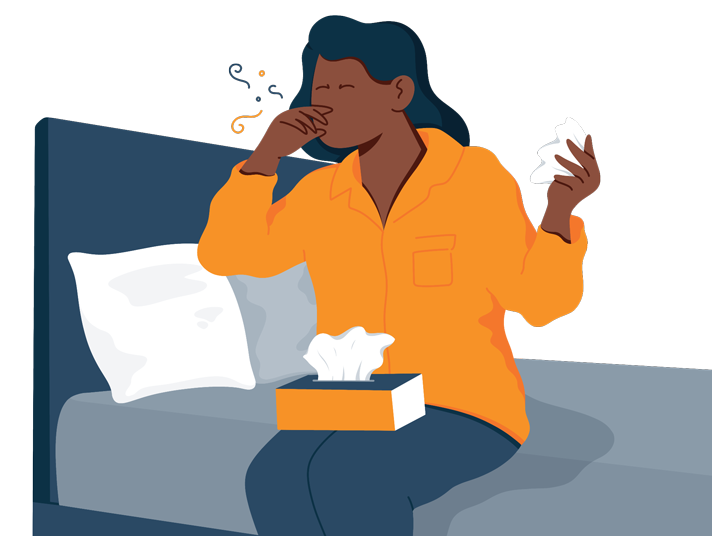Allergies can cause enormous discomfort for many individuals, and they can be challenging to single out and identify. Reactions range from mildly irritating to life-threatening conditions, so it’s critical to keep them well-managed for our health.
Allergic reactions occur when your immune system recognizes an otherwise harmless substance as an “invader,” causing your immune system to trigger a response. When your body confronts these “intruders,” it creates the reaction as a method to rid itself of these substances.
Unfortunately, some beds are made with materials that aren’t conducive to everyone’s sensitivities. Below, we discuss memory foam and its allergic inclinations, so you can pick a perfect bed for your needs.
What are Memory Foam Mattresses Made Of?
Memory foam mattresses are made with a variety of substances. However, they have a reputation for containing harmful ingredients; this isn’t always the case, but it’s wise to check before purchasing. Most of these beds have two main components, a polyurethane memory foam layer and a polyurethane foam core layer. These are then wrapped in a cover, and all mattresses must have flameproofing of some sort to meet federal safety regulations.
As innovative technology emerges, more brands are incorporating cooling gels into their designs to combat this foam’s tendency to retain heat. Many include gel, gel-infused foam, wool, cotton, or latex.
Many individuals are familiar with these materials, but the concern primarily comes from the foam and fireproofing chemicals. These can include methylene aniline— a suspected carcinogen, vinylidene chloride— an eye irritant, and formaldehyde. We’ll dive into the details below.
Want to read more? Check out our best memory foam mattress guide here.
How Can a Memory Foam Mattress Cause an Allergic Reaction?
There are numerous ways allergic reactions can be triggered. Particular smells can be irritating; accumulated dust can cause a response, and even the materials that make up the foam itself can be an issue. Below we’ll talk a bit about the various ways allergies can be caused and what you can do to mitigate or possibly eliminate the problem.
The Smell
Many beds can produce a scent due to the materials and chemicals comprising the product. The smell is often referred to as off-gassing. A smell and VOCs (volatile organic compounds) are created when these disperse out of the mattress.
These substances have been known to cause allergic reactions in some cases. When looking to buy a mattress without any of these substances, be sure to read the label thoroughly. Additionally, upon finding out you already have a bed that contains these ingredients, an organic or 100% cotton mattress topper could act as a barrier and mitigate these effects.
The Foam Mattress Chemicals
Many foam products contain chemicals that could be harmful to some individuals. Various beds are made with chemicals to create products at a lesser cost, financially benefiting the manufacturer. When mattresses are packaged, particularly the bed-in-a-box type, this can create a hotbed of condensed chemicals, and once unboxed, are emitted into the environment.
Lawsuits have been filed against the Tempurpedic memory foam’s harmful VOCs and the allergic issues they’ve caused. If one of the many individuals who prefer a bed without these chemicals, take a careful look at the materials it’s made with and do your research to be confident of what they are.
Get More Info: Toxic Materials in Foam Mattresses
The Dust
Dead skin cells cover just about everything in your home because we’re constantly shedding. Humans are known to shed 30,000 to 40,000 skin cells each hour, and dust mites live by eating dead skin cells. As a result, dust mites thrive because they have an abundance of nutrients.
Dust mite excretions are often what trigger allergic reactions, not necessarily the dust mites themselves. Your body can detect these as harmful substances, creating antibodies as if you have a disease and cause redness or puffy eyes as a result. These critters love living in mattresses because we spend so much time there, so they’re nearly impossible to avoid.
Memory Foam Mattress Allergy Symptoms
Symptoms can show up in many ways. However, there are a few that tend to be more common than the rest.
Nausea
Nausea is when you feel an uneasy sensation in your stomach, which can include vomiting. When battling regular nausea, you may be experiencing an allergic reaction to your mattress. You can try to mitigate this by buying a new mattress or using an organic cotton protector or perhaps even a latex topper.
Irritated Nose
Having a painful nasal cavity may be the most common allergic reaction. We often experience this during seasonal changes, when trees and flowers begin to bloom, or when we’re confronted with a substance that our body believes to be an intruder; these could include cat hair, dust mites, or dander.
Dizziness
Another symptom of an allergic reaction could be dizzy spells. Chemically induced dizziness can lead to fainting, headaches, or vertigo-like symptoms. If you notice this happening regularly, or mainly when you’re at home and near your mattress, your bed may be the culprit.
Rashes
Rashes and hives are a clear indicator of an allergic reaction. These can range from mild to severe. However, regardless of the severity, they’re often itchy and uncomfortable. Due to the visible red skin symptoms, rashes are easy to detect, whereas an irritated nose could be attributed to many causes.
How to Avoid a Reaction if You are Allergic to a Mattress
There are a few ways you can mitigate allergic reactions when you find yourself sensitive to your mattress. When purchasing a bed in a box, allow it to off-gas for a few days longer than recommended, this will enable it to release any additional undesirable chemicals and pests.
Further, if you already have a bed that you aren’t ready to replace, throw a mattress protector over it that’s made from organic material. You can often find ones made of organic cotton, which could provide a barrier, mitigating allergic reactions. Be sure to wash your protector regularly and the mattress cover if it’s removable, which will minimize dander, dust, and other potential allergens.
Additionally, try to keep pets off the bed. With fur babies in the house, it can be difficult to tell them no; however, they could be carrying an abundance of foreign critters that could be causing or exacerbating your condition.
Can Dust Mites Live in a Memory Foam Bed?
We all shed thousands of dead skin cells constantly. As a result, mites live everywhere because dust mites live off of dead skin cells. There are arguments supporting all different types of mattresses regarding the better pick to mitigate mites. However, they all will harbor them to some degree.
Latex can be easy to clean, making it an excellent choice if you prefer to vacuum it regularly to reduce mites and dust. Foam and other flat surfaces can also be vacuumed and cleaned thoroughly. When combating dust mites, these types should be superior to innerspring because innerspring models can harbor many critters inside the structure, making it difficult to clean thoroughly.
Using a hypoallergenic cover is likely the easiest and most effective solution to mites. Don’t forget you can clean your pillows; vacuuming these regularly can help to minimize your bed buddies as well.
Read More: How to Get Rid of Dust Mites in Your Mattress
Can Memory Foam be Bad for Asthma Sufferers?
Irritations and allergies as a result of your mattress material could exacerbate asthma. Pollen issues often arise seasonally and are usually easier to identify because it’s not an everyday occurrence in your daily life. For example, maybe you notice more difficulty managing your allergies or asthma during the spring or summer months when many plants are in bloom.
However, dust mite allergies or asthma attacks could happen year-round if they’re a result of your mattress. Being in contact with your bed daily can make it hard to pin down the culprit, but keep in mind, it could be the primary cause of your asthma.
What Are Some Memory Foam Mattress Alternatives?
A great way to prevent symptoms is to avoid harmful materials or memory foam altogether. Searching for organic, toxin-free beds is an effective way to solve these issues and find some relief. Keep an eye out for hypoallergenic materials or organic brands that consider allergies, asthma, or intolerances.
To get you started, we’ve compiled guides for the best mattresses for allergies and the best organic mattresses.
Further, adding an organic latex mattress topper could provide an effective barrier between you and your mattress. A topper could prevent you from breathing in allergy-infused air, easing your reactions without compromising the pressure relief of your bed.
Additionally, using a standard coil mattress is a great alternative to foam, and these often provide just as much if not more comfort and durability. Be mindful these can harbor just as many mites. However, they could offer an additional option in terms of materials to suit your needs and accommodate asthma or allergies.
If you’re sure you need a more aggressive approach, we recommend trying out a mattress protector that fully encases your bed to trap dust mites or harsh smells without missing out on the comfort you like.
Conclusion
Dust mites will always be ever-present guests in our home. However, how we manage them can be changed to suit our needs. If you suffer from chronic allergies, there is a possibility it could be your mattress, so keep a close eye on how you react—whether or not you experience allergies inside your home or continuously outside as well.
If you believe your mattress is the cause of your discomfort, there are ways to mitigate this issue. Remember our tips and tricks for creating a better sleeping arrangement for yourself, and hopefully, you’ll be sleeping with ease in no time.

Rachael Gilpin
Content Writer
About Author
Rachael is a content writer for Sleep Advisor who loves combining her enthusiasm for writing and wellness.
Back Sleeper



